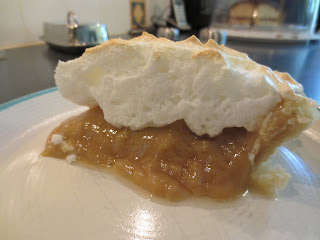As I am someone who doesn't really have the time or inclination to cook through an entire series of sometimes difficult, sometimes costly recipes, I figure this type of blog isn't for me. I do, however, have a large bookcase full of cookbooks. I've cooked recipes from most of these cookbooks, but not all. In my own twist on the "cook-through" blogging concept, I have decided to cook a recipe or two from each and every cookbook I own and blog about the results. I will post these entries approximately whenever I feel like it, and will finish whenever I stop buying cookbooks (which will probably be when I have a toe-tag on in some morgue). They will not be my only posts.
I'm not going to go in any particular order. To begin, I grabbed a small booklet which I purchased for historical interest, entitled 250 Superb Pies and Pastries. It was published in 1952 by Consolidated Book Publishers in Chicago, IL. It was edited by one Ruth Berolzheimer who was at the time the director of something called the Culinary Arts Institute. There's an interesting article about Ms. Berolzheimer and the Culinary Arts institute which you can find here. Here's an interesting quote from the article for you, though:
""I thought she was kind of a lousy cook, to tell the truth," says Henry, who sometimes had breakfast at his aunt's Hyde Park apartment. Her nephews believe their aunt's talents mostly lay in organization and publishing."
Apparently she was a better cookbook editor than actual cook.
I decided to try a recipe for a pie which I have never made, and which sounded old-fashioned. Ok, I didn't go for the Grapefruit Pie, Prune Pie or Shartlesville Pumpkin Pie (made with an entire cup of whiskey), because I wanted something we might actually eat. Although come to think of it, I might try the Shartlesville Pumpkin Pie at some point, when the children aren't around. I opted for Butterscotch Pie.
To make Butterscotch Pie, you actually have to follow three different recipes in three different places in the cookbook. Since the pie recipe requires a baked pie shell, I started with that. Although it nearly killed me, I was determined to follow the recipes as written. I normally make my pie crusts with at least half butter, because I like the taste. This recipe used shortening only:
Plain Pastry
2 cups flour, sifted
3/4 tsp salt
2/3 cup shortening
4 to 6 tablespoons cold water.
Sift flour and salt together and cut in shortening with 2 knives or pastry blender.
 |
| I like this kind of pastry cutter. The ones with just wires suck. |
 |
| I end up with something that looks like this. I actually enjoy doing this part. |
 |
| You will note here that I have cheated and will be rolling out the portion on the left, which is more than half. |
 |
| You know how cookbooks and cooking shows have the cook rolling out perfect circles of dough? I have no idea how they do that. |
 |
| You can pick up the plastic wrap, turn it upside down, and just slap that puppy right into the pie pan. |
...then use one of the following methods to prevent shrinkage of crust: Place rolled dough in pan and set aside for 5 minutes, then find into place with a ball of dough. (I have no idea what that means.) OR Line pastry shell with waxed paper and partially fill with rice or beans, remove paper after first 10 minutes of baking. OR Fit a second pan inside on crust, remove pan after first 10 minutes. That's the method I chose. Bake in a very hot oven (450 F) about 15 minutes or until delicately browned.
 |
| Maybe could have used a bit more browning, but this is after 15 minutes. |
Butterscotch Pie
3/4 cup brown sugar
1/4 cup granulated sugar
1/3 cup flour
2 cups scalded milk
1/8 teaspoon salt
3 egg yolks, beaten
1 1/2 tablespoons butter
1 teaspoon vanilla
1 baked Pastry Shell
1 recipe Meringue II
Combine sugars with flour, add hot milk gradually, stirring constantly to make a smooth mixture. Add salt and cook in top of double boiler for 15 minutes, stirring occasionally, until thickened.
 |
| Don't own a double boiler, but a metal bowl over simmering water works just fine. |
...cover with meringue and proceed as directed.
Ok, so now we have to go look at the Meringue II Recipe.
Meringue II
3 egg whites
6 tablespoons sugar
1/2 tsp vanilla
Beat eggs until frothy. Add sugar gradually...
...and continue beating until stiff.
Add flavoring. Pile on pie and bake in a slow oven (325 F) 15 to 18 minutes.
 |
| I've never actually baked a pie with meringue on it before. I've read that the meringue needs to go all the way to the crust to seal in the filling. That's what I did. |
And then, here's the slice. I waited about 15 minutes before slicing the pie. Apparently that wasn't enough. The recipe didn't say to chill it first, but I suspect the filling wouldn't have been quite so runny if I had. There also seemed to be some clear liquid in the bottom of the pie plate--something separated, but I'm not entirely sure what.
How did it taste? My first reaction was, "Holy cow, that's awfully sweet." The filling was sweeter than I had expected, and with 6 tablespoons of sugar, the meringue was plenty sweet as well. The pie crust wasn't buttery, but it was tender and flaky. Would I make it again? Probably not, but it was good experience. Maybe they liked their pies a bit sweeter in 1952!







No comments:
Post a Comment